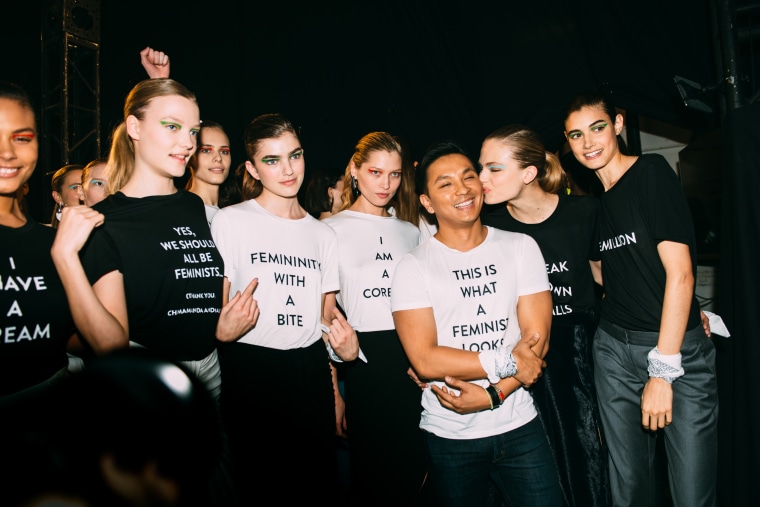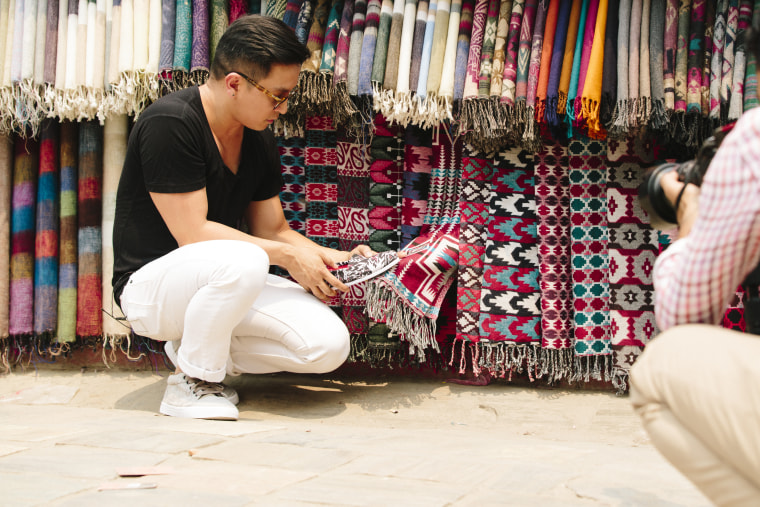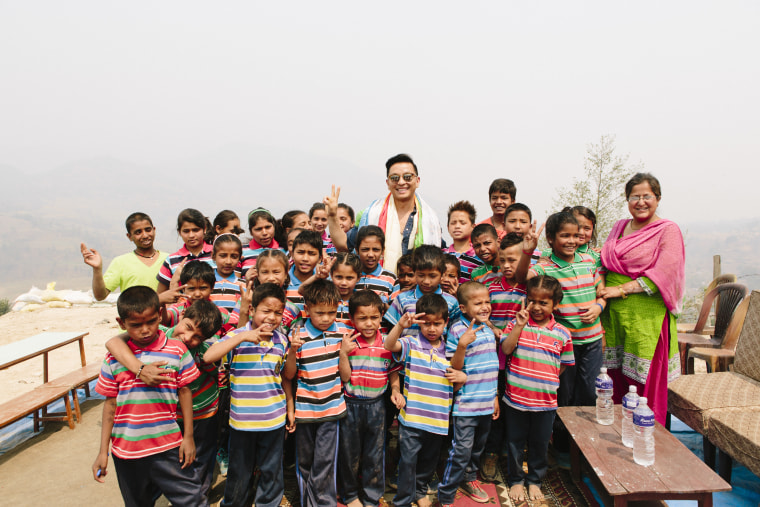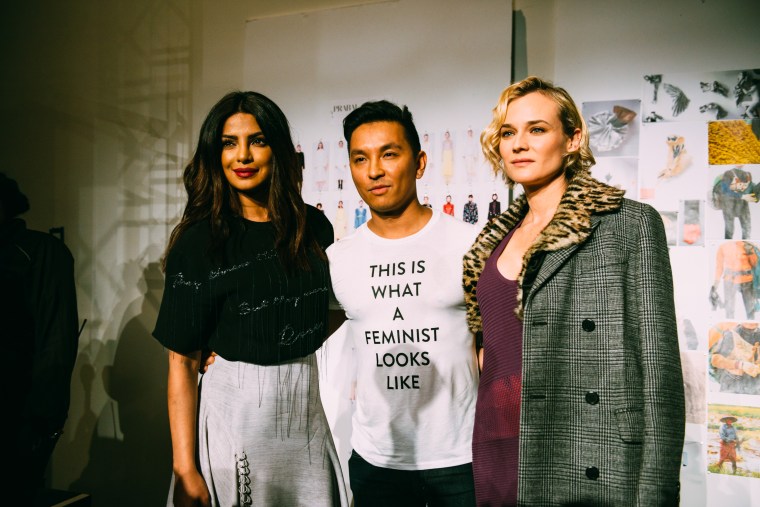Unlike some designers, Prabal Gurung is outspoken on social and political issues. In the finale of his last show, Gurung sent his models down the runway with t-shirts imprinted with slogans including: “I am an immigrant” and “Revolution has no borders." Gurung himself sported one that said: "This is what a feminist looks like."
Hailing from Nepal, Gurung has risen to become one of the fashion world’s most celebrated designers since his launch in 2009 at New York Fashion Week.
"Everyone warned me against launching my own label during a recession, but I felt this was my time to try."
Educated at the Parsons School of Design, he first joined the teams of designers Cynthia Rowley and Bill Blass before launching his namesake label, made for women who possess what he calls "femininity with a bite." He has also dressed some of the world’s most recognizable women, including former First Lady Michelle Obama and Kate Middleton, the Duchess of Cambridge.
NBC News spoke with Gurung about his latest fashion show presentation, his roots in Nepal, the women who inspire him most, and why he insists on not keeping quiet.
You have valued feminism and activism since the beginning of your career. Can you share what the root of your feminist values and activist perspectives stem from?

My mother has always been the guiding force for the type of person I’ve wanted to be and have become.
Growing up and attending an all-boys school in Nepal, I knew what it was like to be different. My mother always allowed and encouraged me to be myself. She always said that she wanted to change the idea that the higher you go, the fewer women there are. It was she who instilled this feminist spirit in me.
You have a phrase, "femininity with a bite," that you are encouraging women to define for themselves. But what does it mean for you?
I’ve defined our woman as ‘femininity with a bite’ since our start in 2009. For me, this means she is someone who embraces her feminine side and celebrates her beauty, without apologizing for or hiding her intellect and wit.
Your last show was very political. Many designers shy away from being involved politics, but you're going at it head on. What drives you to use your platform as intentionally as you do?
It’s a crucial time for our country, for the world really. As a designer with a platform, I feel a responsibility to use my voice and to lead the conversation in a way that can provoke change.
I’ve been told by some to keep quiet — that fashion and politics do not mix and that I should stick to my trade, however I cannot disagree more. I feel compelled to take a stand and challenge notions of what fashions’ role can be in our society.
You're also a supporter of size diversity. Why is this important to you? Do you see this catching on widely within the industry?

I have always believed it is important to celebrate diversity of all types: size, race, age, creed, the list goes on. When I think of the woman I am inspired by, she is complex and layered. I want to celebrate these layers and these differences.
I do believe that the industry is embracing diversity, but this is only the beginning. One of my motives behind partnering with Lane Bryant started at a diversity panel I sat on a few years back. A woman from the audience raised the issue of the lack of size diversity in the industry, and the panel gave a dismissive answer of “we’ll get to you.” It was frustrating to hear such a response, especially when it related to the majority of American women.
While change has been slow, it is inspiring to see other designers also a part of this conversation. I encourage everyone from all walks of life to embrace diversity. This needs to be a collective change, a global change, and I am hopeful that together we can make it happen.
Have you always known you were going to be a fashion designer? When and how did you know?
I’ve known I wanted to be a designer almost since I can remember. I started watching "House of Style" by Elsa Klensch when I was 4 years old, and it inspired me to want to design.
Though I was quite different than the other schoolboys in Nepal, I am fortunate enough to have come from such a supportive family. My family encouraged me to chase and achieve my dreams, and I am so grateful to them for letting me be who I am.
How does your Nepalese heritage inspire your approach to your work, and your life?
Nepal will always serve as a source of inspiration — sometimes it is the country’s colors and textures, and other times it is Nepalese art and architecture — it varies.

Regardless of how the inspiration is manifested, Nepal is my home and a part of who I am as a designer. It both grounds me and drives me. Nepal is a reminder of all I work for, and I am fortunate enough to have developed a platform to advocate for and create opportunity in Nepal.
We work with a knitwear factory in Nepal that employs over 50 percent women and follows ethical and sustainable practices. It is important to both my brand ethos and me personally to work with the community in Nepal in this way.
Of all your creations, what is the most important/memorable piece that you have designed and why?
I am very grateful that I was given the opportunity to design an atelier gown for the former First Lady Michelle Obama for the White House Correspondents Dinner. It was a moment that truly helped shaped my career.
How has dressing former First Lady Michelle Obama impacted you not only as a designer, but as a person?
Dressing the former First Lady Michelle Obama is a true honor. She is an inspiring woman, full of passion, integrity, intelligence, and compassion and embodies every part of the PG woman.
After dressing her for the first time, I vividly remember calling my mother in Nepal, thrilled to tell her about this big moment. I so clearly remember her response, telling me “now, you are not just a designer. You have a platform, and a voice for the people of Nepal.”
It was such a motivating and inspiring moment and the platform it gave me led to the start of my foundation, Shikshya Foundation Nepal, which aims to provide education to children in Nepal.
Socially and politically speaking, how do you view fashion's role in creating positive social impact?
"My mother always allowed and encouraged me to be myself. She always said that she wanted to change the idea that the higher you go, the fewer women there are."
I absolutely believe that as a designer and a member of a highly visible industry, I have a responsibility to use my platform and voice to make a positive impact and invoke change. From day one, my goal has been to create a luxury brand with a soul, and to me that means the ability to see other people in different walks of life, and to create an open dialogue. This notion led to the idea of our t-shirt finale at the Fall 2017 show.
Additionally, it is this platform that has enabled me to start my foundation, Shikshya Foundation Nepal. Since our start five years ago, we have provided education to over 200 children and aided in earthquake relief efforts, helping more than 15,000 families. I believe that fashion is my mechanism to incite social change, and I cannot have one without the other.
What trials and challenges have you faced in your career, and how did you overcome them?
When I launched in Fall 2009, I had left my position as design director at Bill Blass. We were deep in recession and I went on unemployment. Everyone warned me against launching my own label during a recession, but I felt this was my time to try. Every part of my career has been defined by grit and dedication to see my dream through.
This interview has been edited for length and clarity.
Follow NBC Asian America on Facebook, Twitter, Instagram and Tumblr.
